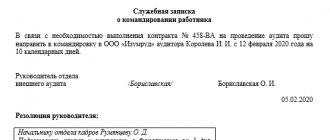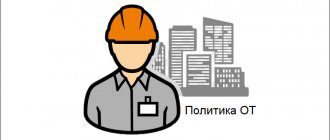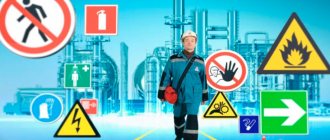Why do we need a regulation on the occupational safety management system in an organization?
The need to draw up a provision is determined by the requirements of GOST R 12.0.007-2009.
All Russian employers must follow GOST standards in the field of labor protection (Article 22 of the Labor Code of the Russian Federation). The regulation on the occupational safety management system in the organization is included in the list of mandatory documentation regulating the functioning of the system (clause 7.8.5 GOST R 12.0.007-2009, clause 4.3.4 GOST R 12.0.009-2009).
At the same time, employees of the organization must have unhindered access to this provision.
Regulations of occupational safety and health standards in production
If your production requires a really functioning OSMS (and not for unsubscribing to management - which we strongly discourage), we recommend developing an OSMS provision in production in 5 stages:
- identifying areas of application of the occupational safety management system;
- compiling a database of regulatory and legal documentation;
- delineation of duties, powers and responsibilities;
- description of procedures included in the OSMS;
- interrelation of OSH procedures and local labor protection documentation.
Which regulations establish requirements for the preparation and structure of the document?
Despite the fact that drafting a regulation is an obligation established at the federal level, the Russian Federation has not adopted regulations regulating how this document should be formed and what it should look like.
In Art. 209 of the Labor Code of the Russian Federation states that it is within the competence of federal authorities to approve a standard provision on the occupational safety management system, which should be formed taking into account the opinion of the bodies regulating social and labor legal relations.
However, such a standard provision has not yet been adopted as a normative document. True, it was published in the form of a draft by the Ministry of Labor of the Russian Federation, which is now being actively discussed by various departments.
This document was developed taking into account the current labor protection standards adopted in the Russian Federation and abroad, as well as the practical experience of leading employer companies. The draft standard provision contains, in particular:
- requirements for the structure of internal corporate regulations;
- provisions defining the policy and goals of the employer company in the field of labor protection;
- provisions establishing how the company's labor protection system should operate;
- provisions defining how personnel training in the field of labor protection should be carried out;
- provisions regulating the organization of document flow within the framework of the labor protection system at the enterprise.
At a meeting of the Russian Tripartite Commission, which took place in early February 2021, it was decided that the current draft standard regulation of the Ministry of Labor needs to be finalized. Experts noted that this document assumes that employing companies will face a number of unjustified risks.
In the absence of legal provisions that would regulate the preparation of regulations on the occupational safety management system, Russian employers will have to work on developing this source independently. Let's study how this problem can be solved.
The nuances of drawing up the regulations on the occupational safety management system were explained by ConsultantPlus experts:
Study the material by getting trial access to the K+ system for free.
What documents should I fill out to organize a labor protection service?
To organize a labor protection service, complete:
- an order to appoint an occupational safety specialist, if occupational safety work is carried out by a full-time specialist;
- regulations on the labor protection service, if a separate structural unit has been created;
- agreement if a third-party accredited organization or specialist has been engaged to provide services in the field of occupational safety and health.
What documents should I prepare to organize a labor safety management system?
To organize an occupational safety and health management system, develop and approve by order of the director an OSMS regulation
on the basis of a standard provision, which was approved by the Ministry of Labor by order No. 438n dated August 19, 2016. Next, approve the occupational safety policy - it may be part of the OSH regulations, and an action program to improve working conditions and safety.
To check the effectiveness of the OSMS, issue an order to conduct an internal audit of the OSMS and an audit plan. Based on the results of checking the effectiveness of the OSMS, draw up a report on the results of the internal audit of the OSMS and register it in a special journal, if it is maintained at the enterprise.
SITUATION
Is it necessary to re-approve labor protection documents annually?
If the document has not lost its relevance and the revision period has not expired, there is no need to re-approve the documents.
The employer himself establishes the procedure for the development, coordination, approval and revision of documents of the occupational safety management system, their storage periods (clause 66 of Order of the Ministry of Labor dated August 19, 2016 No. 438n). That is, the employer himself decides when to re-approve the documents. Rostrud adheres to the same position (clause 1 of letter dated March 22, 2012 No. 428-6-1).
Review the document if it is no longer relevant or the planned revision period established by law has expired. For example, labor safety instructions are reviewed at least once every five years (clause 6 of the Methodological Recommendations of the Ministry of Labor dated May 13, 2004).
ATTENTION
Control and accounting documents of the occupational safety and health management system are not subject to revision, including:
a) acts and other data records arising from the implementation of the occupational safety and health management system;
b) log books and acts of recording data on accidents, incidents, occupational diseases;
c) recording data on the impact of harmful (hazardous) factors in the working environment and the labor process on workers and monitoring working conditions and the health status of workers;
d) results of monitoring the functioning of the OSMS.
This follows from paragraph 67 of the Order of the Ministry of Labor dated August 19, 2016 No. 438n.
ADVICE
In order not to miss the deadline for revising a specific document:
1. Make a list of local acts on labor protection of the organization.
2. By order on organization:
- approve by the employer the list of local acts on labor protection of the organization;
- for each document, determine the planned revision period and document storage period;
- Assign a person responsible for reviewing each document.
3. Make changes to the document.
4. Issue an order to review and implement the amended document(s).
SITUATION
What position should be entered in the labor protection documents for an employee who combines the duties of a labor protection specialist?
Combination means additional work in another profession or position that an employee performs along with his main job for an additional fee.
The combination is formalized by an additional agreement to the employment contract. Based on the additional agreement, an order is issued to combine professions (positions). The employee does not have any other job, and he is not assigned a new position. Therefore, on the documents that the employee signs, he should indicate his main position. In this case, an order to combine professions (positions) will confirm the authority of the employee in labor protection. If necessary, a link to the order can be indicated next to the signature: “based on the order of combination dated May 23, 2016 No. 443.”
Such conclusions follow from the totality of the provisions of Articles 60.2, 72, 151 of the Labor Code.
If an employee performs the duties of a labor protection specialist in the form of not combining positions, but temporarily performing the duties of a temporarily absent employee without release from his main job, then when signing labor protection documents, instead of his current position, he can indicate “and. O." and the position of the employee being replaced. For example, “I. O. occupational safety specialist (personal signature) A.S. Ivanov." This possibility is provided for in paragraph 5.22 of GOST R 7.0.97-2016.
SITUATION
How long to store labor safety certificates
The storage time for labor safety certificates depends on the situation for which the certificate was drawn up.
Acts on providing workers with PPE
, rinsing and neutralizing agents, milk and other food products, therapeutic and prophylactic nutrition are stored for three years. If, in addition to these acts, there are no other documents on harmful and dangerous working conditions for the employee, then they must be stored for 75 years if executed before January 1, 2003, 50 years - if after January 1, 2003 (clause 427 of the list, approved by order Rosarkhiv dated December 20, 2019 No. 236).
Acts on investigation and recording of occupational diseases
are stored for 75 years if issued before January 1, 2003, 50 years if after January 1, 2003 (item 419 of the list, approved by order of the Federal Archive of December 20, 2019 No. 236).
Acts on industrial injuries, accidents and accidents
In production, store for 45 years at the place of preparation. However, if the acts record large-scale material damage and human casualties, then the acts must be kept indefinitely. If the act was drawn up in another organization, then it only needs to be stored for five years (item 425 of the list, approved by order of the Federal Archives of December 20, 2019 No. 236).
Acts on the maintenance of buildings, structures, structures and adjacent territories
Store in proper technical and sanitary condition for three years (item 539 of the list, approved by order of the Federal Archive of Russia dated December 20, 2019 No. 236).
Certificates of compliance or non-compliance
store the sanitary, epidemiological and hygienic requirements of operating conditions, territories, buildings, structures, structures, premises, equipment, vehicles for five years. Then the document can be selected for permanent storage based on the results of an examination of its value (item 429 of the list, approved by order of the Federal Archive of December 20, 2019 No. 236).
What documents should I submit to assess professional risks?
To organize an assessment of professional risks, write down the assessment regulations in the organization’s regulations on OSH. Next, create a register of hazards based on the results of identifying these hazards at the enterprise (clause 34 of the Standard Regulations on OSH, approved by Order of the Ministry of Labor dated August 19, 2016 No. 438n).
To eliminate or reduce identified risks, create a risk adjustment plan. In addition, indicate the results of the risk assessment and all its intermediate and final procedures in the profit risk report.
An action plan and a report on professional risks are not mandatory documents, but if they are drawn up, they will help to confirm, if necessary, that the enterprise has properly assessed occupational risks (clause 38 of the Standard Regulations on OSH, approved by order of the Ministry of Labor dated 08/19/2016 No. 438n).
What documents should I submit for labor protection control?
Record the results of labor protection control in the structural divisions of the enterprise (order of the Ministry of Labor of Russia dated August 4, 2014 No. 524n):
- in the act of checking the state of labor protection;
- instructions to eliminate violations of labor protection requirements identified during inspections;
- log of labor safety inspections.
What documents should I submit for training of company employees?
To conduct instructions and training on labor protection, develop and approve labor safety instructions, briefing programs and labor protection training programs. Complete a list of current instructions in any form.
ATTENTION
Additionally, develop a training program for employees of the organization to provide first aid to those injured at work.
To register instructions and training of workers on labor protection, prepare logs:
- registration of induction training;
- registration of workplace training;
- registration of targeted instruction;
- taking into account labor safety instructions for workers;
- accounting for the issuance of labor protection instructions for workers.
If the enterprise has exempted employees from initial training at the workplace, the director approves the list of professions and positions of these employees.
To test workers' knowledge, issue an order to test knowledge of workers' labor protection requirements. Based on the results of the knowledge test, publish the minutes of the meeting of the commission for testing knowledge on labor safety and issue workers with certificates of testing knowledge of labor protection requirements.
If the results of training require an internship at the workplace, draw up a regulation on conducting an internship at the workplace and, based on the results, issue an order on admission to independent work.
SITUATION
Is it necessary to approve the list of labor safety instructions by order of the enterprise
? No, it is not necessary. It is enough to create only the list itself
Current labor protection instructions for employees of a structural unit of the organization, as well as a list of these instructions, are kept by the head of the unit (clause 9 of the Methodological Recommendations of the Ministry of Labor dated May 13, 2004). However, there are no mandatory requirements for the preparation of this list. That is, the employer draws up the list in any form and decides whether to approve it by order or not.
SITUATION
What to do with labor protection documents after the liquidation of an organization
After the legal entity has closed, the documents must be transferred to the state archive so that former employees can receive certificates or other documents, for example, to assign a pension or establish length of service. There are such archives in every municipal entity in the constituent entities of the Russian Federation (clauses 8, 10 of Article 23 of Law No. 125-FZ of October 22, 2004).
To generate documentation for the archive, create a liquidation commission that will collect documents in accordance with the list approved by Order of the Federal Archive of December 20, 2019 No. 236, and draw up an act on the transfer of cases. The act must be certified with the seal of the organization; accordingly, the documents must be transferred for storage until the seal is destroyed.
SITUATION
Is it necessary to develop internship programs?
An internship program must be developed if the organization has jobs in which employees need to be sent for an internship at the workplace. Internship is mandatory for workers who enter work in harmful or dangerous working conditions. This is indicated in Part 3 of Article 225 of the Labor Code and paragraph 2.2.2 of the Procedure approved by Resolution No. 1/29 of January 13, 2003.
SITUATION
How long to keep the induction briefing log and the workplace briefing log
The introductory briefing log and the workplace briefing log are kept for 45 years. This follows from subparagraph “a” of paragraph 423 of the list, approved by order of the Federal Archives of December 20, 2019 No. 236.
What documents should I submit for medical examinations?
Provide employees with a referral before the medical examination. Record the issuance of referrals in the journal for recording the issuance of referrals for a preliminary medical examination.
For periodic medical examinations, draw up a list of employees subject to periodic medical examinations, and on its basis - name lists of persons subject to periodic medical examinations.
To conduct pre-trip medical examinations, draw up the Regulations on the organization of pre-trip medical examinations of drivers of motor vehicles.
Record the fact of medical examinations in the log of pre-trip, pre-shift medical examinations, and the log of post-trip and post-shift medical examinations.
SITUATION
Where are documents on preliminary and periodic medical examinations stored?
After medical examinations
the medical institution draws up a conclusion on the employee’s health status, and based on the results of the periodic medical examination, also a final report. Keep the conclusion in the employee’s personal file, and the final act in the place where all the organization’s documents on medical examinations are stored.
The medical organization draws up a conclusion on the employee’s health status based on the results of examinations in four copies after the preliminary examination and in five copies after the periodic medical examination. In any case, the copies are:
- employee;
- employer;
- the medical organization to which the employee is attached;
- to add to your medical record.
After the periodic medical examination, another copy of the report is drawn up at the written request of the FSS and sent to this department with the written consent of the employee.
The final report, which summarizes all the results, is drawn up by the medical organization after a periodic medical examination. This act is drawn up in five copies:
- employer;
- to the center of occupational pathology of a constituent entity of the Russian Federation;
- FSS;
- to the territorial body of Rospotrebnadzor.
One copy of the final act is stored in a medical organization for 50 years (clauses 42 and 43 of Order No. 302n).
What documents should I fill out when issuing free preventive nutrition to employees?
Approve the list of positions and professions of workers who, due to working conditions, are given free preventive nutrition (milk, juices, etc.).
If an employee receives an application to replace milk with cash compensation, then issue an order to replace the milk supply with cash compensation.
What documents to fill out when issuing flushing and neutralizing agents?
Approve the list of workplaces and the list of employees for whom the issuance of flushing and neutralizing agents is required.
Issue orders:
- on approval of standards for the free distribution of flushing and neutralizing agents to employees;
- organizing the free distribution of cleaning and neutralizing agents to employees.
Record the issuance of flushing and neutralizing agents to employees in a personal record card for the issuance of flushing and (or) neutralizing agents.
What documents should I fill out when issuing personal protective equipment to employees?
Draw up a regulation on providing workers with personal protective equipment and approve a list of professions and positions for which free work clothes, safety shoes and other personal protective equipment (hereinafter referred to as PPE) are issued.
After purchasing PPE, keep certified copies of certificates and declarations of conformity for PPE at the enterprise.
Issue PPE to employees upon the order approving the standards for the free issuance of workwear, safety footwear and other personal protective equipment and record the fact of issue in a personal record card for the issuance of personal protective equipment.
SITUATION
How long to store personal records cards for the issuance of PPE
The storage period for a personal record card for the issuance of PPE is not clearly indicated in the list approved by Order No. 236 of Rosarkhiv dated December 20, 2019, against which the duration of storage of documents is verified. However, the list under paragraph 428 indicates the storage periods for lists (statements) for the issuance of protective clothing, footwear and food; these may also include registration cards for the issuance of PPE. The employer must keep a personal record card for issuing PPE for one year. The beginning of this period is usually considered to be January 1 of the following year after the dismissal of the employee for whom the card was issued.
An employer must keep records of the personal protective equipment it provides to employees. To do this, in accordance with paragraph 13 of the Intersectoral Rules for Providing Workers with Special Clothing, Special Footwear and Other Personal Protective Equipment, approved by Order of the Ministry of Health and Social Development dated June 1, 2009 No. 290n, the issuance and return of PPE is reflected in the personal record card for the issuance of PPE. You can also keep PPE accounting cards in electronic form with the obligatory identification of the employee.
What documents to fill out when investigating an accident at an enterprise?
When investigating an accident, make a request to the medical facility regarding the severity of the injury. Get an opinion on the severity of your work injury.
Issue an order to create a commission to investigate the accident.
Send a message about the accident to the Social Insurance Fund and a notice to the state labor inspectorate, to the prosecutor's office at the place of the accident, to the territorial association of the trade union organization, to the federal executive body according to departmental affiliation, etc.
Document the results of the investigation. Documents must include:
- plans, sketches, diagrams, protocol for examining the scene of the incident, and, if necessary, photo and video materials;
- special job assessment cards;
- extracts from logs of registration of occupational safety briefings and protocols for testing victims’ knowledge of occupational safety requirements;
- protocols of interviews with eyewitnesses of the accident and officials, explanations of the victims;
- expert opinions of specialists, results of technical calculations, laboratory studies and tests;
- medical report on the nature and severity of the injury to the victim’s health;
- copies of documents confirming the issuance of PPE to the victim in accordance with current regulations. These may be journals for recording and issuing PPE, a personal card for recording and issuing PPE;
- other documents at the discretion of the commission.
Based on the results of the investigation, depending on the type of accident, draw up an investigation report for a group accident (serious accident, fatal accident) and an accident investigation report in Form N-1.
Send a message about the consequences of an industrial injury to the Social Insurance Fund and the state labor inspectorate after the victim brings a closed sick leave certificate.
Register the accident in a special journal.
SITUATION
Is it necessary to stitch (stitch) an accident case after it has been fully investigated
? No, it is not necessary.
The Labor Code and Resolution of the Ministry of Labor dated October 24, 2002 No. 73 obliges the employer to conduct an investigation of an industrial accident and collect investigation materials.
The procedure for preparing accident investigation materials is established by Article 230.1 of the Labor Code and does not contain requirements for stitching and stitching investigation materials.
The employer has the right to establish requirements for stitching and stitching accident investigation materials independently by administrative document for the organization.
What documents should I fill out for a special assessment of working conditions?
To conduct a special assessment of working conditions (hereinafter referred to as SOUT), approve by order:
- composition of the commission for conducting the special assessment;
- SOUT schedule.
Make a list of jobs that need to be assessed.
Sign the report on the results of the SOUT.
Submit a declaration to the labor inspectorate if no harmful or dangerous production factors have been identified at the workplace and acceptable and optimal working conditions have been established.
What documents should be drawn up when carrying out occupational safety measures?
Issue an order to prepare an action plan to improve working conditions and safety and approve an action program to improve working conditions and safety.
The occupational safety action plan is approved by order.
What documents should I submit for training non-electrical personnel?
By order, appoint someone responsible for assigning electrical safety group I to non-electrical personnel.
Approve the list of positions and professions that need to be assigned Group I in electrical safety. Record the briefing in a special journal. Material taken from the Occupational Safety and Health System.
Nuances of developing regulations on the occupational safety management system at the enterprise
The regulations are prepared by responsible specialists of the employing company. In accordance with paragraphs. 4.5.1 and 4.5.2 GOST 12.0.230-2007 when developing documentation within the framework of the labor protection system, it is necessary to pay attention to the following nuances:
- one should take into account the size of the organization, the types of activities it carries out, the specifics of the technological processes that characterize its production;
- the content must be presented in a form that will be understandable to employees;
- documentation must be analyzed and corrected in a timely manner.
Thus, when developing a regulation, it should be taken into account that it is not adopted once and for all, but may require periodic changes.
Structure
The regulation on the assessment of working conditions can be divided into the following sections:
- general provisions;
- terms and definitions used in the instructions;
- stages of special assessment;
- rights and obligations, the procedure for interaction during the special assessment;
- final provisions.
As a sample when preparing to write this regulatory document, we recommend using the procedure set out in Section I of the Rules for the Preparation of Regulatory Legal Acts, approved by Decree of the Government of the Russian Federation of August 13, 1997 No. 1009.
Regulations on the labor protection system: structure
The structure of the position can be represented by such elements as:
- title page;
- general provisions section;
- section on the functional responsibilities of company employees in the field of labor protection;
- section on specialized enterprise structures responsible for labor protection;
- section regulating the completion of labor safety training by employees;
- section regulating the procedure for testing employees' knowledge of labor protection;
- section regulating the implementation of measures to monitor and improve the labor protection system;
- section regulating the actions of employees in case of accidents at work;
- a section establishing the responsibility of employees for failure to comply with the requirements of the regulations on the labor protection system;
- attachments to the document necessary to regulate the procedure for its use by employees (for example, a logbook for registering employees’ familiarization with the regulations).
Let us consider in more detail what formulations may be contained in the marked sections.
***
Existing standards oblige all employers to have specialized provisions regulating the occupational safety and health management system. However, at present there is no clear form of such a local act; none of the existing legislative acts has introduced it. In this regard, business entities need to independently develop its form, a list of sections and determine their content. The option we have presented takes into account the latest trends, as well as existing standards and provisions of regulations, and therefore can be successfully used by most employers for the purpose of practical development of the specified internal document.
Similar articles
- Standards for the number of workers, managers, specialists and employees
- Model training program on labor protection
- Sample order for the creation of a labor safety commission
- Sample regulations on the occupational safety management system
- Model training program on labor protection
Section 2: General Provisions
This section of the document may include language reflecting:
- for what purpose does the organization approve the regulations on the labor protection system;
- what kind of norms are established by the document;
- the fact that the provision is a local regulatory source, the norms of which are mandatory for compliance by all employees of the organization;
- the fact that the regulation is a fundamental document when conducting training activities as part of improving the labor protection system;
- in accordance with which legal acts the provision was developed;
- How often can the document be revised?
Section 3: Functional Responsibilities of Employees
Here is a list of employees responsible for:
- control over the functioning of the labor protection system in the company;
- ensuring compliance of local regulations of the company, adopted for the purpose of functioning of the labor protection system, with the provisions of legal acts at the federal, regional and local levels;
- monitoring the implementation of the provisions of local acts in the field of labor protection by employees;
- developing methods for improving the current mechanisms within which the labor protection system operates;
- organizing training for employees aimed at acquiring knowledge in the field of labor protection;
- practical implementation of the standards governing the functioning of the labor protection system at the enterprise, in terms of providing employees with protective equipment, instructions for their use, access to security systems and other infrastructure facilities of the enterprise, which are involved in the process of labor protection;
- responding to industrial incidents and ensuring their investigation;
- implementation of social protection measures for employees from industrial incidents and occupational diseases;
- conducting a special assessment of working conditions in the manner prescribed by the legislation of the Russian Federation;
- conducting training for employees on occupational safety programs with the involvement of freelance instructors from specialized organizations or departments;
- control over the correct maintenance of documentation used within the framework of the labor protection system at the enterprise.
Contents of the standard provision
The draft model provision sets out the following points:
- a list of sections that must necessarily be included in the provision and the sequence of their presentation;
- an indication of the objectives pursued in the field of labor protection;
- reflection of the mechanisms, methods and algorithms through which the labor protection process will be implemented;
- the procedure for organizing personnel training in the field of ensuring safe work, the frequency of its implementation;
- procedures for organizing document flow on labor protection.
As a result of an analysis of the resulting draft, at a meeting of the tripartite commission, which took place in early 2021, it was decided to rework the document due to the flaws it contained. Since the final version was never adopted, business entities will have to develop samples and instructions for them on their own. In order to solve this problem, a more detailed consideration of the instructions in this regard available in the legislative framework is required.
Section 4: Occupational Safety and Health Management Bodies
The main such body should be the labor protection service, which, in accordance with the provisions of Art. 217 of the Labor Code of the Russian Federation must be established by employers with a staff of more than 50 people.
If the company has fewer employees, management must appoint at least 1 person responsible for occupational safety and health. In this case, the labor protection management body in the company will be sole. If this is not possible, then the functions related to ensuring the functioning of the labor protection system should be taken over by the head of the company or individual entrepreneur (if the business is conducted in this legal form). Or you should involve a third-party specialist under a contract and form an external labor protection management body.
In this section, you can record wording that reflects:
- what kind of labor protection management body has been established in the company: a service, a single person in the form of a responsible specialist or an external one in the form of a contractor;
- an indication that the labor protection service (or the specialist responsible for labor protection, or the contractor) performs its functions in accordance with Art. 217 Labor Code of the Russian Federation;
- who exactly in the organization establishes a labor protection service or appoints a responsible specialist (most often this is the manager);
- the main tasks that are solved by the labor protection service, the responsible specialist or the contractor.
How will they punish
Unfortunately, the legislation does not establish exactly when each enterprise must fulfill the obligation to create its own occupational safety management system . However, labor inspectors must check:
- is there such internal documentation;
- how adequate it is or whether it is made “for show”.
Do not forget that the absence of an OSMS falls under the first and fifth parts of Article 5.27.1 of the Code of Administrative Offenses of the Russian Federation. And the fine here can reach 200,000 rubles or suspension of activities. This is especially worth thinking about for those organizations in which work is associated with a risk to the life and/or well-being of employees.
Also see “Standard employment contract: who, why and when can conclude it.”
Read also
15.11.2016
Section 5: Employee Training and Instruction
This section of the document can include language that reflects:
- the fact that all employees of the company hired must undergo training in labor safety programs, as well as the necessary instructions;
- the essence of briefings conducted in the organization;
- how training and instruction should be conducted;
- what standards does the enterprise follow when organizing employee training on labor safety programs, as well as when conducting briefings;
- who exactly approves training and instruction programs, and also carries out relevant activities;
- an indication that upon completion of each training program or instruction on labor protection, the knowledge acquired by employees is tested;
- an indication that training and instruction programs are conducted in accordance with the company’s local regulations;
- frequency of review of training programs and instructions adopted by the company, as well as local regulations that govern their implementation.
Consolidating the frequency and methodology of employee training
In this part of the provision you need:
- approve the obligation of all newly hired persons to undergo preliminary safety training in the workplace;
- reflect the content of the briefings that employees undergo;
- determine the methodology of training events and the procedure for familiarizing new employees with instructions;
- provide regulations that affect the procedure for conducting briefings and training of employees;
- indicate the persons who have the right to approve training programs, the content of instructions and methods of familiarization with them;
- prescribe how to evaluate the acquired knowledge after the completion of the briefing procedure;
- indicate the need to carry out introductory procedures in strict accordance with local regulations adopted by the company;
- determine the validity period of the company’s applicable familiarization procedures, briefings and training plans.
Section 7: monitoring and optimization of the labor protection system
This section may contain language that reflects:
- who exactly at the enterprise is responsible for monitoring the functioning of the labor protection system, as well as its improvement;
- what criteria are used to assess the quality of operation of the relevant system;
- what methods are used to monitor the functioning of the labor protection system, as well as its optimization;
- Who exactly at the enterprise controls the work of employees responsible for monitoring and improving the labor protection system.
Analysis and improvement of labor protection mechanisms in the company
To describe optimization procedures in the field of labor protection, the document may include the following points:
- a list of persons who regularly check the existing system and develop proposals for its improvement;
- parameters that are analyzed in the process of assessing existing mechanisms;
- a list of tools used to assess the current state of the labor protection system;
- procedure for administering the work of employees analyzing and optimizing the labor protection system in the organization.
Section 8: Procedure for Actions in Case of Industrial Accidents
This section of the regulation may include language that discloses:
- procedure, methods of accident investigation;
- the procedure for the response of company employees and its management to accidents;
- the procedure for adopting local regulations in accordance with which accident investigations should be carried out;
- who exactly is responsible for responding to industrial incidents;
- in what order is the interaction between company employees and external entities, in particular special services and government departments, carried out during industrial incidents;
- the procedure for reflecting information about accidents in special documents, a list of relevant documents;
- who exactly is responsible for entering information about industrial incidents into special documents.
Approval of rules of conduct and sequence of actions in case of accidents
A rather important part of the provision, which states:
- the procedure for investigating accidents, the techniques used;
- a list of priority measures that employees and managers should take in the event of an accident;
- regulations for the approval of local documentation defining the methods and procedure for conducting the investigation;
- information about persons who are obliged to take the necessary measures in the event of an accident;
- procedures for interaction between the company, external services and government agencies in the event of an accident;
- a list of documents drawn up upon the occurrence of facts leading to adverse consequences for employees, and the procedure for entering relevant information into them;
- a list of persons responsible for documenting the facts of incidents that occurred.
Section 9: Employee Responsibility
The section on responsibility is a standard element of most local regulations, so its inclusion in the structure of the regulations on the labor protection system is also possible. In this section you can record wording that reflects:
- in accordance with which legal acts the company’s employees are responsible for failure to comply with labor safety standards;
- an indication that all employees of the enterprise bear responsibility for non-compliance with the provisions of the document, as well as what disciplinary measures may be imposed on violators.
Another possible element of the regulation on the labor protection system is the appendices to it. Let's take a closer look.
List of applications
The regulations on the labor protection system can be supplemented by various sources regulating the operation of the document itself or the individual procedures that it regulates. All of them will have application status.
Thus, sources that confirm the legal force of the document itself include a journal in which employees of the organization certify with their signature the fact of familiarization with the regulations on the labor protection system (or receiving a copy of it).
Sources regulating individual procedures within the framework of the occupational safety management system include a journal that records employees’ access to the enterprise’s safety systems, as well as to the premises in which training or instruction on occupational safety programs is carried out.
The log of familiarization with the regulations, the log of access control and other documents should receive the status of applications with a certain number, and it is advisable to provide their forms in the regulations themselves.
All such applications must be approved by order of the director (this may be the same order that puts into effect the regulation on the labor protection system itself).
Each application must indicate that it was compiled specifically for the provisions on the labor protection system. It is best to reflect this mark as a reference to the number of the local regulatory act by which the provision was approved and which is indicated on the title page. In this case, the application can be printed separately from the position, for example, for employees of certain divisions of the company.
Additional materials attached to the regulation
The described document may have as attachments copies of the regulations on which it is based and which give it legitimacy, internal local acts of the company necessary in the process of labor protection. Copies are attached for the information of all interested parties.
In addition, the application can be a log of employees’ familiarization with the specified provision, where they certify the fact of reading (receiving in hand) one copy. It would be useful to add a log that records the fact that the employee has undergone safety training. It may also record the employee's access to equipment and premises. All listed journals that act as appendices must be numbered, and it is advisable to enshrine their forms in the text of the regulation.
All applications must be approved by order of the manager. In addition, they must contain a note indicating that they are specially formed as appendices to the regulations on the labor protection system. As a rule, this is done in the same administrative document that introduced the provision and which is indicated in its title part. Thus, it will be possible to use the applications separately and transfer them to company employees.
Results
The regulation on the labor protection system at the enterprise is a document that, in accordance with GOST standards, all Russian employers must have. Since its recommended form has not been approved at the moment, the enterprise must develop this document independently. The structure of the regulation on the labor protection system proposed by our experts is based on the practice of modern personnel management and reflects the basic requirements of the regulatory GOST.
You can familiarize yourself with other aspects of ensuring occupational safety at an enterprise in the following articles:
- “Frequency of testing knowledge on labor protection (nuances)”;
- “How is introductory training on labor protection carried out?”
You can find more complete information on the topic in ConsultantPlus. Free trial access to the system for 2 days.








